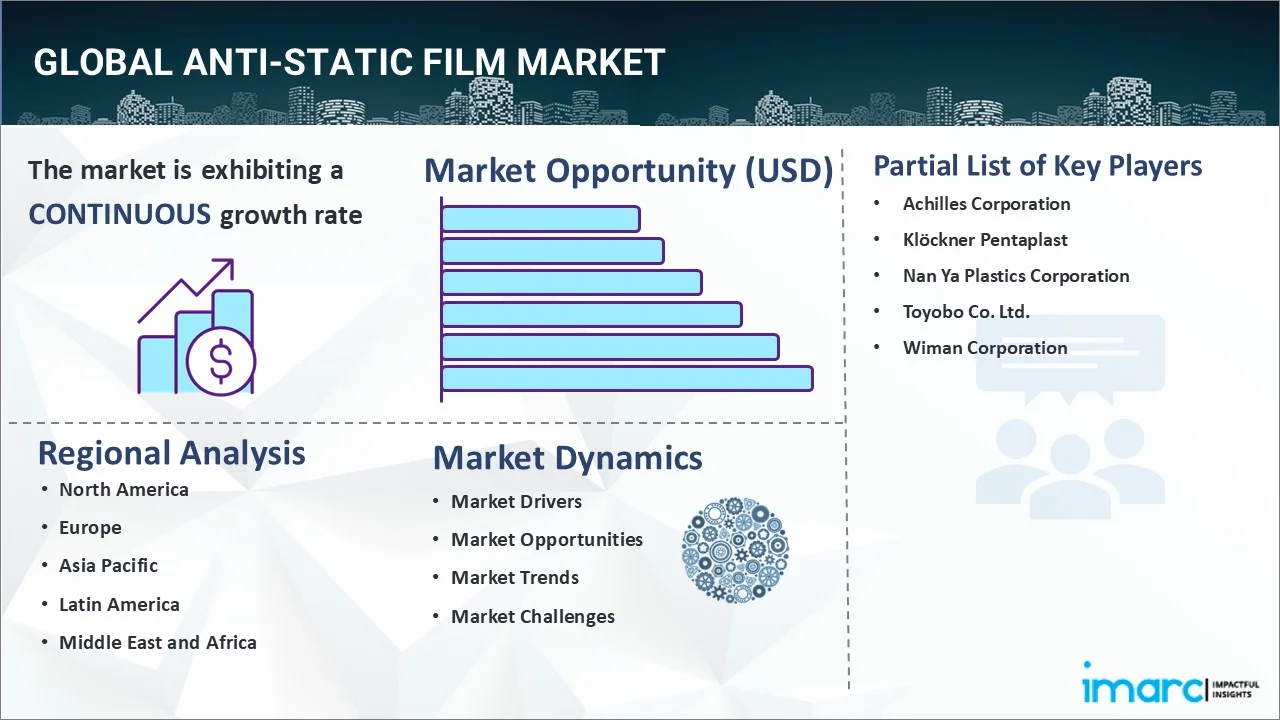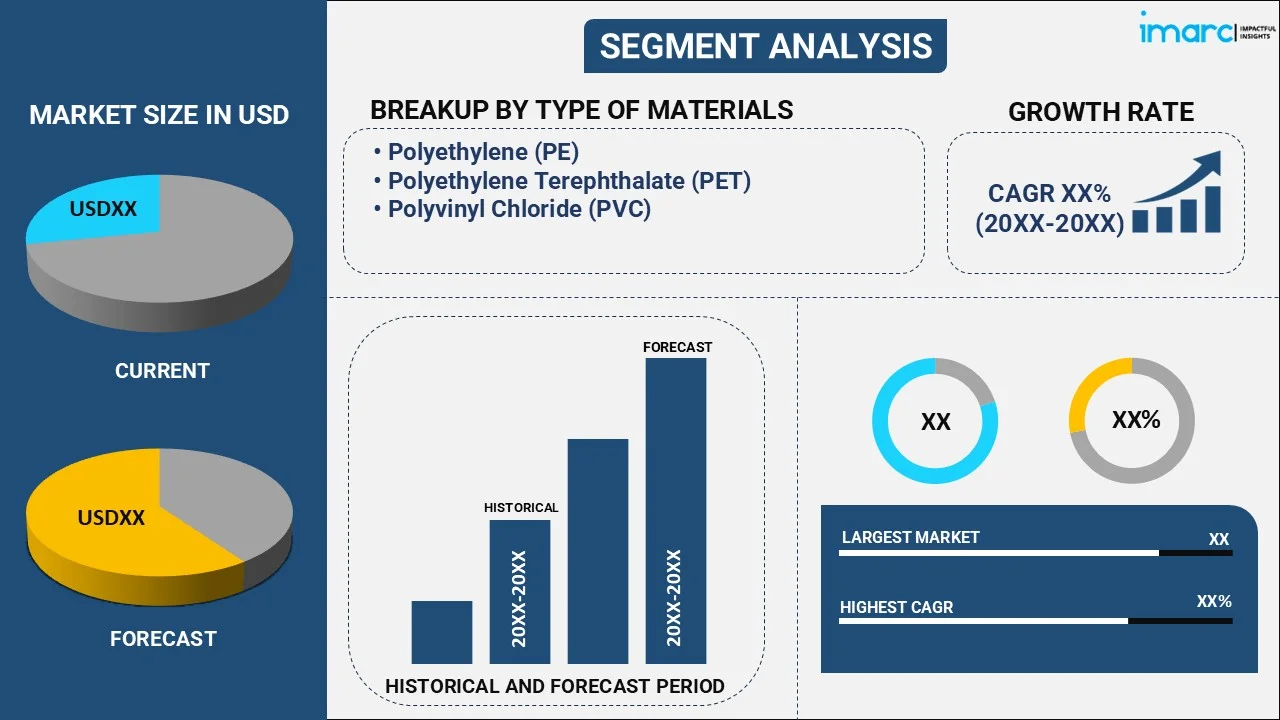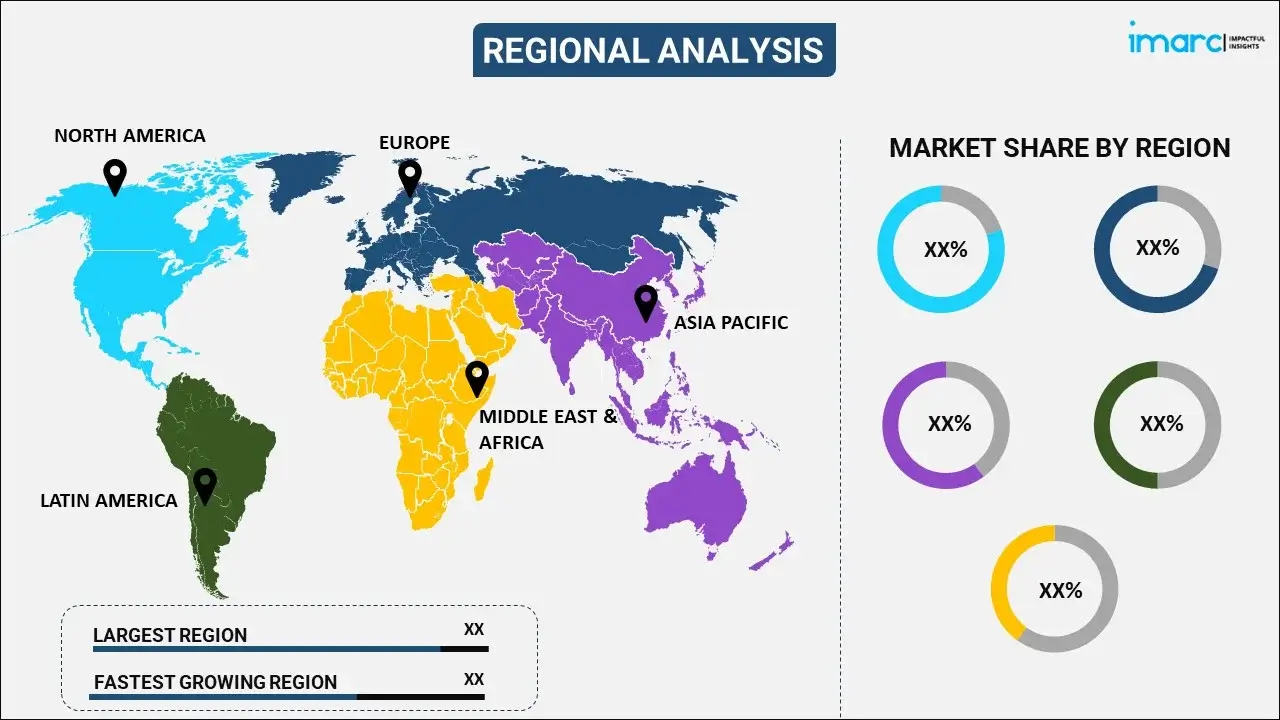
Anti-Static Film Market Report by Type of Material (Polyethylene (PE), Polyethylene Terephthalate (PET), Polyvinyl Chloride (PVC)), Application (Electronics and Semiconductor, Manufacturing, Healthcare and Life Sciences, Automotive, and Others), and Region 2025-2033
Market Overview:
The global anti-static film market size reached USD 506.3 Million in 2024. Looking forward, IMARC Group expects the market to reach USD 723.2 Million by 2033, exhibiting a growth rate (CAGR) of 4.04% during 2025-2033.
|
Report Attribute
|
Key Statistics
|
|---|---|
|
Base Year
|
2024
|
|
Forecast Years
|
2025-2033
|
|
Historical Years
|
2019-2024
|
|
Market Size in 2024
|
USD 506.3 Million |
|
Market Forecast in 2033
|
USD 723.2 Million |
| Market Growth Rate 2025-2033 | 4.04% |
The anti-static film is a thin, transparent plastic sheet that is designed to prevent or reduce the buildup of static electricity. It is made by adding conductive materials, such as carbon black or metallic particles, to the plastic film during the manufacturing process. These films are used for packaging electronic components, such as circuit boards, computer chips, and other sensitive electronic devices. Anti-static films help in protecting products and components from physical damage during transportation. These films also assist in preventing static-related problems, improving product quality, and protecting sensitive electronic components from damage. In addition, they are cost-effective, versatile, customizable, and recyclable. As a result, anti-static films find extensive applications across various industries, including electronics and semiconductors, manufacturing, healthcare, and life sciences, and automotive.

Anti-Static Film Market Trends:
The widespread product adoption in the electronics and packaging industries across the globe is one of the key factors driving the market growth. Anti-static films are widely used to protect sensitive electronic components during handling, storage, and transportation. In line with this, the increasing product utilization to protect flexible displays from scratches, dust, and electrostatic discharge used in smartphones, wearable devices, and other electronic gadgets is favoring the market growth. Moreover, the growing awareness regarding the hazards of electrostatic discharge (ESD) and its effects on electronic equipment and products is acting as another growth-inducing factor. Apart from this, the introduction of advanced materials, such as carbon nanotubes, graphene, and metal oxides, that provide superior conductivity and durability and help to enhance the performance of anti-static films are providing an impetus to the market growth. Additionally, the increasing product application in the food and beverage (F&B) industry to protect food items from contamination and preserve hygienic value during transportation is propelling the market growth. Furthermore, the rising environmental consciousness among the masses and the growing trend towards the development of eco-friendly anti-static films that are recyclable, biodegradable, and free from hazardous substances are positively influencing the market growth. Other factors, including the rising penetration of the e-commerce industry, enhanced research and development (R&D) activities, increasing expenditure capacities of consumers, widespread adoption of polyethylene terephthalate (PET), and growing demand for pouches, bags, and sacks made of anti-static films for storing and packaging pharmaceutical products are anticipated to drive the market growth.
Key Market Segmentation:
IMARC Group provides an analysis of the key trends in each segment of the global anti-static film market, along with forecasts at the global, regional, and country levels from 2025-2033. Our report has categorized the market based on type of material and application.
Type of Material Insights:

- Polyethylene (PE)
- Polyethylene Terephthalate (PET)
- Polyvinyl Chloride (PVC)
The report has provided a detailed breakup and analysis of the anti-static film market based on the type of material. This includes polyethylene (PE), polyethylene terephthalate (PET), and polyvinyl chloride (PVC). According to the report, polyethylene (PE) represented the largest segment.
Application Insights:
- Electronics and Semiconductor
- Manufacturing
- Healthcare and Life Sciences
- Automotive
- Others
The report has provided a detailed breakup and analysis of the anti-static film market based on the application. This includes electronics and semiconductor, manufacturing, healthcare, and life sciences, automotive, and others. According to the report, electronics and semiconductor represented the largest segment.
Regional Insights:

- North America
- United States
- Canada
- Europe
- Germany
- France
- United Kingdom
- Italy
- Spain
- Russia
- Others
- Asia Pacific
- China
- Japan
- India
- South Korea
- Australia
- Indonesia
- Others
- Latin America
- Brazil
- Mexico
- Others
- Middle East and Africa
The report has also provided a comprehensive analysis of all the major regional markets, which include North America (the United States and Canada); Europe (Germany, France, the United Kingdom, Italy, Spain, Russia and others); Asia Pacific (China, Japan, India, South Korea, Australia, Indonesia, and others); Latin America (Brazil, Mexico, and others); and the Middle East and Africa. According to the report, Asia Pacific was the largest market for anti-static film. Some of the factors driving the Asia Pacific anti-static film market included the widespread product adoption in the electronics and packaging industries, increasing product application in the food and beverage (F&B) industry, and extensive research and development (R&D) activities.
Competitive Landscape:
The report has also provided a comprehensive analysis of the competitive landscape in the global anti-static film market. Detailed profiles of all major companies have also been provided. Some of the companies covered include Achilles Corporation, Klöckner Pentaplast, Nan Ya Plastics Corporation, Toyobo Co. Ltd., Wiman Corporation, etc. Kindly note that this only represents a partial list of companies, and the complete list has been provided in the report.
Report Coverage:
| Report Features | Details |
|---|---|
| Base Year of the Analysis | 2024 |
| Historical Period | 2019-2024 |
| Forecast Period | 2025-2033 |
| Units | Million USD |
| Type of Materials Covered | Polyethylene (PE), Polyethylene Terephthalate (PET), Polyvinyl Chloride (PVC) |
| Applications Covered | Electronics and Semiconductor, Manufacturing, Healthcare and Life Sciences, Automotive, Others |
| Regions Covered | Asia Pacific, Europe, North America, Latin America, Middle East and Africa |
| Countries Covered | United States, Canada, Germany, France, United Kingdom, Italy, Spain, Russia, China, Japan, India, South Korea, Australia, Indonesia, Brazil, Mexico |
| Companies Covered | Achilles Corporation, Klöckner Pentaplast, Nan Ya Plastics Corporation, Toyobo Co. Ltd., Wiman Corporation, etc. |
| Customization Scope | 10% Free Customization |
| Post-Sale Analyst Support | 10-12 Weeks |
| Delivery Format | PDF and Excel through Email (We can also provide the editable version of the report in PPT/Word format on special request) |
Key Questions Answered in This Report:
- How has the global anti-static film market performed so far, and how will it perform in the coming years?
- What are the drivers, restraints, and opportunities in the global anti-static film market?
- What is the impact of each driver, restraint, and opportunity on the global anti-static film market?
- What are the key regional markets?
- Which countries represent the most attractive anti-static film market?
- What is the breakup of the market based on the type of material?
- Which is the most attractive type of material in the anti-static film market?
- What is the breakup of the market based on the application?
- Which is the most attractive application in the anti-static film market?
- What is the competitive structure of the global anti-static film market?
- Who are the key players/companies in the global anti-static film market?
Key Benefits for Stakeholders:
- IMARC’s report offers a comprehensive quantitative analysis of various market segments, historical and current market trends, market forecasts, and dynamics of the anti-static film market from 2019-2033.
- The research study provides the latest information on the market drivers, challenges, and opportunities in the global anti-static film market.
- The study maps the leading, as well as the fastest-growing, regional markets. It further enables stakeholders to identify the key country-level markets within each region.
- Porter's five forces analysis assist stakeholders in assessing the impact of new entrants, competitive rivalry, supplier power, buyer power, and the threat of substitution. It helps stakeholders to analyze the level of competition within the anti-static film industry and its attractiveness.
- Competitive landscape allows stakeholders to understand their competitive environment and provides an insight into the current positions of key players in the market.
Need more help?
- Speak to our experienced analysts for insights on the current market scenarios.
- Include additional segments and countries to customize the report as per your requirement.
- Gain an unparalleled competitive advantage in your domain by understanding how to utilize the report and positively impacting your operations and revenue.
- For further assistance, please connect with our analysts.
 Inquire Before Buying
Inquire Before Buying
 Speak to an Analyst
Speak to an Analyst
 Request Brochure
Request Brochure
 Request Customization
Request Customization




.webp)




.webp)












